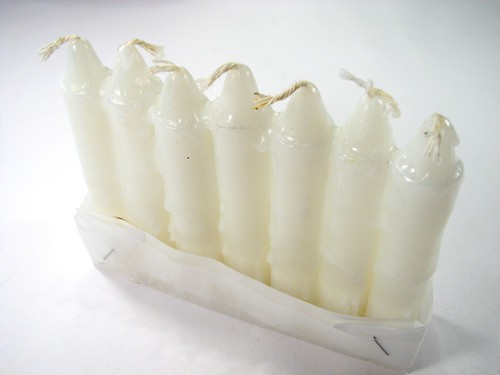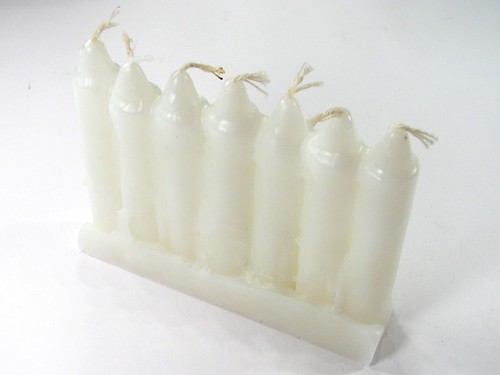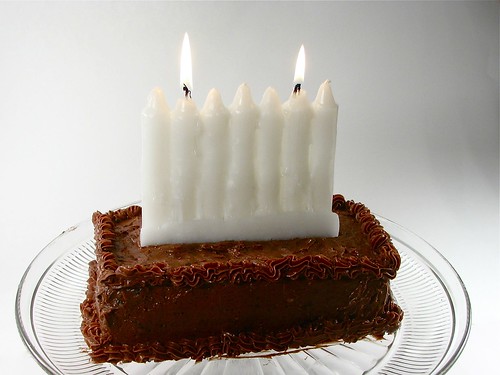I am this many.
Have you ever heard of the unary number system, i.e., base-1 numerals? That’s the formal designation of tally marks– a means of representing a number symbolically by using symbols, where the number represented is equal to the number of symbols. While easy to grasp, it’s also a rather inefficient system, so we don’t find too many uses of them in modern life. One of the places that we do (almost) always use the unary system is on birthday cakes, where a birthday cake has one candle per year. This is fine for small numbers, but positioning, lighting and blowing out candles becomes impractical past a certain point.
Here’s a better way: A binary birthday candle. It consists of a single candle with seven wicks, where the wicks that are lit represent the birthday individual’s age in binary. This single candle design works flawlessly to represent any age from 1 to 127, never requiring anyone below the age of 127 to blow out more than a mere six candles at a time.
You can make this fused single candle yourself:

Our starting point is a set of seven regular candles from the grocery store, plus a couple of extras that will be sacrificed for their wax.

Fold a little rectangular trough out of non-stick parchment paper, big enough to fit the seven candles side by side. The paper accepts creases well, but furiously rejects scotch tape, so our solution to make the box work is to *staple* the fold-over tabs (that don’t touch the inside of the trough), and then tape it together with one big loop of scotch tape around the outside. (The tape sticks to itself.)

Next, we need heat. This handy lighter works well for the job, but there are other options as well. Melt the candles together on their interfaces. A helpful trick is to take one or two more candles and (using the lighter) melt and drip their wax into the trough, and/or into the gaps between the candles. Be careful not to accidentally light the candles!

Here is our fused mono-candle.

The parchment paper simply *does not stick* to the wax, so this comes out very easily, leaving a neat and clean rectangular base.
Add to cake and light. (If you don’t know your binary, you can always get help.)
Before you light it, it’s a very good idea to use scissors and trim down the wicks that you *won’t* be using, that way they won’t accidentally catch on fire.





Happy birthday.
Shouldn’t you use 8 candles? That will support people up to 255 years old (and, hey, I’m planning on living to be, at least, 250!).
Also, have you thought about putting a blank space in to group the digits? That might make it a bit easier to read.
Don’t forget that you have to read it from the correct end (I’ll spare you any discussion of big-endian versus little-endian). Shouldn’t one of the candles be colour coded to indicate which end is the most significant bit?
I don’t suppose adding a bit of a metallic dye to the wicks would be a good idea to make coloured flames, at least not while putting them on something you’re going to eat.
One could always use LEDs instead of candles.
Dave
Happy 33rd. The problem is I’m the only one that would find this amusing/cool, and I’m not likely to prep my own birthday cake.
34th.
Happy Birthday, and many more!
It’s symmetrical, too.
(When my grandmother turned 90, we put the candles on the cake for Roman numerals: XC. It might have been her own idea. Beats having the fire department show up.)
I like the idea of using colors to indicate position. I propose the resistor code,
Black
Brown
Red
Orange
Green
Blue
Violet
Probably with colored wax rather than colored flame – no need to sputter your cake with a microscopic layer of magnesium, sodium, iron, etc.
Plus, there’s really no good "black" candle flame color…
-Adam
I’d have to use the silver band as well, to indicate +/- 10% tolerance on the value. (My birthday was actually last month, but it wasn’t the right time for this article.)
—
Windell H. Oskay
drwho(at)evilmadscientist.com
http://www.evilmadscientist.com/
Actually the best Color code would probably be the 4 pair telecom color code so the candles would be
Blue/White stripped
Blue
Orange/White Stripped
Orange
Green/White Stripped
Green
Brown/White Stripped
Brown
That would also give you a complete byte as apposed to a byte -1 and would take care of the big-endian vs little endian argument…
Happy 34th – Someone already noted that it’s symmetrical in binary, so you’re 34 from both sides of the table. It’s also a palindrome in base 4 ("202"), base 16 ("22"), and trivially in any base 35 or higher (call it "Y", which even has the desired horizontal symmetry).
Finally, 34 is the "ultimate Octal age of life, the universe, and everyting": 42.
Cheers.
I would like to propose to generalize this approach so that not only the age, but the message (such as "Happy 34th Birthday, Windell!") could be communicated as well. So that the communication is reliable, start, stop and parity bits should be added. Of course, smaller candles (i.e. traditional birthday candles) would have to be used in order to keep the frame, er, cake size reasonable.
The problem with this approach is that it goes in the opposite direction of yours regarding lung capacity, fire hazard, etc. Perhaps good data compression could help with these.
Sorry, I couldn’t help myself. <Wanders off mumbling something about storing data using candy sprinkles on a floppy, er, layer cake…>
Looks like that’s already been done. :)
—
Windell H. Oskay
drwho(at)evilmadscientist.com
http://www.evilmadscientist.com/
I love this! My birthday’s in a few weeks and I think I have to insist on a candle like this !
dot
How about using the height of the candles to represent the digits with each one being twice as tall as the previous one? One issue would be that it would look too much like a pan flute, especially if all the candles started off with a common base height and only the top 1/3 or so was doubled (in order to keep the height difference from getting too out of hand).
—
Art Dahm • My Peggy 2.0 Web Page • http://www.mindlessdiversions.com/peggy2/
Nice idea :-)
Another place where most people almost universally use unary is counting with fingers. Switching to binary there also has some benefits. Although others might find the number 4 offensive.
The other benefit is that would benefit having a big blowout celebration whenever you turn a power of two and have only a single candle to blow out. The only one which is in common use today is the Sweet 16, but why not a Sweet 32, Sweet 64, Sweet 128, …?
Or you could follow the Latin tradition of marking a girl’s birthday one year before a power of two, where you would have a solid phalanx of candles lit without gaps. So besides the Quinceañera, you could have the Treinta-y-unoañera celebration featuring five candles list on the traditional cake.
Different color candle for the LSB?
What a wonderful Idea. Genius… perhaps a little evil… I’m glad you gave construction instructions as that would have been my next question.
I’d love to have one of those for my birthday…
aahhh the pure geekeness of it. I must make one of those now.
On reading the candles:
make either the ‘1’ candle or the ’64’ candle a different color? Or both colored but not the same colors?
My favorite feature is that I now only need one candle for the rest of my life, although i guess the ‘1’ candle might eventually get a little low. This could actually be beneficial to the design, since after enough uses, the lower order bits will naturally be shorter, thus solving the reading direction issue . . . eventually
I was thinking of making one of these and found this post when looking for ideas..
Two things:
The least significant bit (LSB) is going to be used A LOT. Because of this, I think it is necessary to NOT have the candle statically set to one direction. Ideally, switching it back and forth from one direction to the other will even out the wear, though even more ideally the outer candles should be longer.
The biggest problem at this point is the placement on the cake. Since I want to use this candle over and over, I want substantial candles. But, I don’t want substantial holes in the cake. My thought was to have two mini stabilizers, but I am not sure how to do this easily (without having to cast the whole candle)
I’ve done this with individual candles, without fusing them.
First, you don’t really need 8 candles. Second, you don’t need a space between the 4th and 5th. He said this is binary, not hexadecimal. So, the result is simply read as 34 (decimal), not 22h. If he meant it to be hexadecimal, then yes, 8 candles would be appropriate, covering 2 4-bit nibbles. Binary and Hex are not the same thing. The earliest computers were binary only, not hexadecimal.
And kids know exactly what their birthday cakes mean – just as soon as you have taught then to count up to 31 on one hand!*
* I fully intend to teach my kids to do this given half a chance.